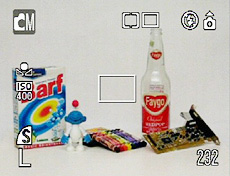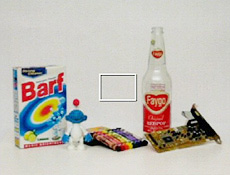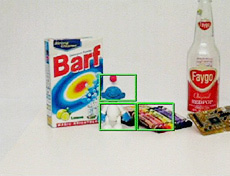Canon PowerShot SD300: The Best Ultra-Compact in its Class?
by Stephen Caston on February 23, 2005 4:00 PM EST- Posted in
- Digital Camera
Recording Features
In all recording modes, the SD300 records images as JPEG files with quality settings: Superfine, Fine, or Normal. The resolution options are below:| Setting | Resolution (pixels) |
| Large | 2272x1704 |
| Medium1 | 1600x1200 |
| Medium2 | 1024x768 |
| Small | 640x480 |
| Postcard | 1600x1200 (Fine) |

| Function Menu (Manual) | |
| Exposure Compensation | +/- 2 stops in 1/3 stop increments |
| White Balance | Auto, Daylight, Cloudy, Tungsten, Fluorescent, Fluorescent H, Custom |
| ISO | Auto, 50, 100, 200, 400 |
| Picture Effect | Off, Vivid, Neutral, Low Sharpening, Sepia, Black & White |
| Image Quality | Superfine, Fine, Normal |
| Resolution | L (2272x1704), M1 (1600x1200), M2 (1024x768), S (640x2480), Postcard (1600x1200, Fine) |
When selecting the Image Quality and Resolution, the camera will estimate how many pictures will fit on the SD card with the current setting. For example, in Manual mode, the camera indicates that we can hold 246 images at the highest quality and resolution settings on our 512MB PNY SD card.
The Digital Macro mode will use the camera's digital zoom to crop out and magnify the center of the image. Because the digital zoom degrades image quality, we recommend using the regular macro mode, which we'll discuss in a bit. Portrait mode will use a large aperture to create an image where your subject is in focus and the background is blurry. In Night Snapshot mode, the camera uses a slow-sync flash to allow ambient light to illuminate the background while the flash illuminates the subject. With Kids & Pets mode, the camera attempts to use a fast shutter speed to capture moving subjects. In Indoor mode, the camera attempts to take pictures without using the flash in order to capture natural-looking indoor images. Finally, Underwater mode is designed for use with the optional underwater casing (AW-DC30). This accessory goes for approximately $120.
In any still recording mode, a direction on the 4-way controller can be pressed to alter specific settings. The available options will vary depending on which recording mode you have selected. Below is a table that outlines all the different options:
| 4-Way Controller options | |
| Up | Light Metering (Evaluative, Center-weighted average, Spot) |
| Down | Single Image Erase/Continuous Drive/Self-timer |
| Right | Flash mode (Auto, Auto w/red-eye reduction, On with red-eye reduction, On, Off, Slow-Synchro) |
| Left | Focus (Macro, Infinity) |
With Evaluative metering, the camera measures light from the entire frame to determine the appropriate exposure. When Center-weighted metering is selected, the camera will measure light primarily in the center of the frame. With Spot metering, the camera will use a very small portion of the center of the frame to determine the best exposure. By default, the camera will show a 2-second review of an image immediately after it is taken. During the review, you can delete an image before it is written to the SD card by pressing down on the 4-way controller. In all modes except Auto, the camera can be set to continuous drive mode where it can shoot images up to 2.4 fps. The Self-timer length can be either 2 or 10 seconds; this is specified in the Setup menu. The "On" flash setting forces the camera to use the flash, even if there is already enough ambient light. Many people use this setting in sunlight to fill in shadows on a subject's face when there is strong backlighting. In Macro mode, the camera can focus on objects as close as 1.2" from the lens. When Infinity focus is selected, the camera will fix its focus to infinity for landscape pictures.
 Info |
 No Info. |
In any recording mode, the Disp button can be pressed to alter/disable the display. By default, the display will contain the following information: shooting mode, quality, resolution, metering, drive, flash, and number of pictures remaining. When the Disp button is pressed, the display is cleared of all information other than the live image. Another press of the Disp button will turn off the LCD to save battery power.
 AiAF On |
 AiAF Off |
With AiAF enabled (via the Setup menu), the SD300 will select one or more focus points automatically when the shutter button is half-pressed. When AiAF is disabled, the camera will always focus on the center point. With AiAF disabled, it is still possible to focus on off-center subjects. To do this, simply half-press the shutter button over your subject. Then, recompose while keeping the shutter button half-pressed. When you have the image framed as you like it, press the shutter button down all the way.
By pressing the Menu button in Manual mode, the SD300 will display 8 options under the Record section of the Menu. The options available will vary depending on the recording mode. Below, we have outlined these options as they appear in Manual mode:
| Record Menu (Manual mode) | |
| AiAF | On, Off |
| Self-timer | 10, 2 sec. |
| AF-assist Beam | On, Off |
| Digital Zoom | On, Off |
| Review | Off, 2 - 10 sec. |
| Date Stamp | Off, Date, Date & Time |
| Long Shutter | On, Off |
| Stitch Assist | Left to right, Right to left |
AiAF refers the the SD300's auto-focus system. If "On" is selected, the camera will select one or more of the 9 focus points. If "Off" is selected, the camera will always focus on the center focus point. The Self-timer amount simply specifies how long the camera will wait before taking a picture when the self-timer is enabled. The AF-assist beam is a bright red light that helps the camera to focus in low-light scenarios. To use the Date Stamp feature, you must first select Postcard (1600x1200) as the image resolution. To use a long shutter speed, you must first select "On" from the Manual mode menu. Then press the Menu button to exit the menu, press the Func./Set button and select the Exposure Compensation option. Now, press the Menu button and select a shutter speed from the following options: 1", 1"3, 1"6, 2", 2.5", 3.2", 4", 5", 6", 8", 10", 13", 15". The Stitch Assist option helps you to align panorama pictures that can later be "stitched" together using the supplied software.
To switch to movie mode, you must slide the Mode Switch to the movie mode position. Below is a table that outlines the available resolutions and frame rates:
| Resolution (Pixels) |
Frame rate (FPS) |
Maximum Length |
| 640x480 | 15, 30 | No |
| 320x240 | 15, 30 | No |
| 320x240 | 60 | Yes, 1 min. |
| 160x120 | 15 | Yes, 3 min. |
The SD300 records video clips with sound as AVI files using the M-JPEG codec. In addition to the options for resolution and frame rate, the SD300 offers the same white balance options and picture effects that are available in the still recording modes. The optical and digital zoom functions are unavailable once the camera has started recording a video clip. In movie mode, the Record menu only offers the self-timer and AF-assist lamp options.
A setup menu is available at all times through the main Menu button. Below, we have outlined the options:
| Setup Menu | |
| Mute | On, Off |
| Volume | Startup, Operation, Self-timer, Shutter, Playback (5 increments each) |
| LCD Brightness | 15 increments |
| Power Saving | Auto Power Down (On, Off) Display Off (10, 20, 30 sec., 1, 2, 3 min.) |
| Date/Time | Set |
| Clock Display | 0 - 10, 20, 30 sec., 1, 2, 3 min. |
| Format | Cancel, OK |
| File No. Reset | On, Off |
| Auto Rotate | On, Off |
| Language | Select |
| Video System | NTSC, PAL |
When "Auto Power Down" is enabled, the LCD monitor will turn off after 1 minute of inactivity (by default). This length of time can be adjusted under the "Display Off" option. The lens will retract and the camera will power down 2 minutes after the display turns off. Interestingly, when the LCD monitor turns off, it can be turned back on by simply rotating the camera to a different orientation. Otherwise, you can just press any button other than On/Off. With the option "File No. Reset" enabled, the camera will reset the file numbering system each time a new SD card is inserted. If "Off" is selected, the camera will continue the file numbering where it left off, even if a new card is inserted.
In addition to the Setup menu, there is a "My Menu" screen where you can select a startup image and operation sounds. Below is a table with the available options:
| My Menu | |
| Theme | Off, 1, 2, 3 |
| Start-up Image | Off, 1, 2, 3 |
| Start-up Sound | Off, 1, 2, 3 |
| Operation Sound | Off, 1, 2, 3 |
| Self-timer Sound | Off, 1, 2, 3 |
| Shutter Sound | Off, 1, 2, 3 |
The Theme options allow you to select themes 1, 2, or 3 that correspond to a specific startup image and operating sounds. Options 1 and 2 of each section are customizable. For example, by selecting "2" as the Start-up Image option, you can press the Disp. button to select your own image. Likewise, you can record or select your own sounds for each of the sound options. These custom settings are saved to the camera's memory, so they are available even after the SD card is formatted.










30 Comments
View All Comments
hoppa - Wednesday, February 23, 2005 - link
The SD300 is an awesome camera, but some note should be made of the very obvious artifacting in the resolution tests. The Canon may display slightly higher resolution than the Nikon, but that comes at a cost: the oversharping causes extreme moire and artifacting issues in very fine detail.Thank you for finally reviewing a top notch camera though!
IceWindius - Wednesday, February 23, 2005 - link
Meh, no thanks, I love my new A85 just fine and dandy.stephencaston - Wednesday, February 23, 2005 - link
AtaStrumf, thanks for the suggestion. Its always sort of tricky finding something suitable for video samples. Believe it or not, sometimes its really hard to find something interesting to shoot. I'll venture more into the downtown scene next time ;-)AtaStrumf - Wednesday, February 23, 2005 - link
OK, read the review. Fabulous camera! A friend of mine has a Canon PS ELPH SD110 (3MP, 2x zoom)http://www.dpreview.com/reviews/specs/Canon/canon_...
Also a nice camera, but the small lens size makes *S*Purple fringing (check spelling in your conclusion) a real pain in the you-know-where (not neck ;-). It shows up big and often, although SD300 seems to be a bit better.
One complaint: a bad movie sample. Shoot something more interesting next time and not so far away and detailed (it really gets blurred-lost), because I don't think anybody will be making IMAX type of movies with it. Show a stroll along the beach, kids playing, fish, cats something close up, colorfull and moving.
AtaStrumf - Wednesday, February 23, 2005 - link
Oh yea, I forgot to stress that the new stuff (lens and CCD sensor) are _THE_ most important features that can single-handedly make or break a camera.And just for those who don't know it yet: IXUS=ELPH (EU/US).
And........, yep I think that's it.
AtaStrumf - Wednesday, February 23, 2005 - link
Haven't read the review yet but I gotta say this right now anyway, because I just saw the pricetag on this IXUS and I already know it's not for me.Just today I was thinking that next time you guys put up a review I gotta ask you to review a Canon PowerShot A510 and/or A520. It may seem just like a A75/A85 in a new form factor, which I suppose it is, but it also has a new lens and there is some confusion about wheather or not both A510 and A520 use the same CCD sensor, so I'd really like to see a review before I buy, but I just can't find any, which is really odd, considering it looks like just the right combination of features and price, which should make it extremely popular choice.
Please, please, please review this camera.
Sorry about the stupid long sentence, but I think it conveys very well exactly what I wanted to say.
PrinceGaz - Wednesday, February 23, 2005 - link
Whew, that seems like the sort of camera I'll get if I fancy something better than my Minolta DiMAGE X20. Only downside I can see to the Canon is that it uses a proprietary battery rather than AA cells so I'd have to take the charger with me rather than simply taking a few sets of ready to use NiMH away with me, but I guess they couldn't have made the camera so small otherwise.Given the Canon's impressive movie capature ability, is there a limit to what size SD card the camera accepts? Will it take 1GB and the recently introduced 2GB SD cards? 640x480 @ 30fps MJPEG will eat the megabytes up pretty quickly, if the 320x240 @ 15fps MJPEG my camera can do is anything to go by.
nels0360 - Wednesday, February 23, 2005 - link
The SD300 is a great little camera. I bought one in December. It does have a couple of drawbacks though.In photos taken in low light, the photos occasionaly come out with a bright white "swirl" in the image. It is the flash refecting off of dust apparently. It is mentioned on the Canon website in the FAQ for this camera. This has ruined more than one of my photos.
Also, as with many ultra-compacts, red-eye is a problem even with the red-eye reduction flash. There is just no avoiding it in some shots, but that is what Photoshop is for.
If you get this camera, make sure to get the Canon leather case designed for it. It is incredibly small, comes in red or black and looks good to boot.
ksherman - Wednesday, February 23, 2005 - link
dont ell me we are russian into the Soviet jokes again...Great review, and a gret product! I defenitly want one of these suckas!
Houdani - Wednesday, February 23, 2005 - link
In Soviet Russia, Canons power shoot YOU!